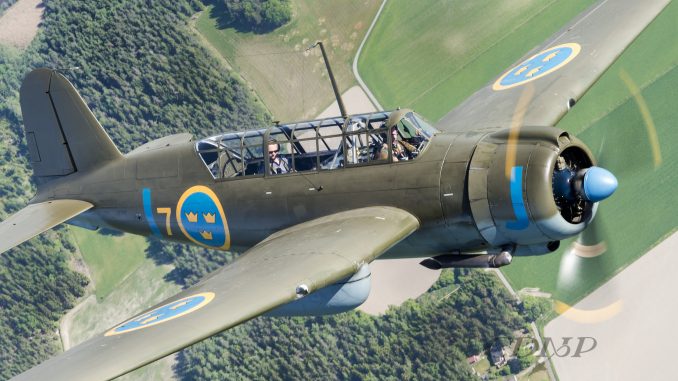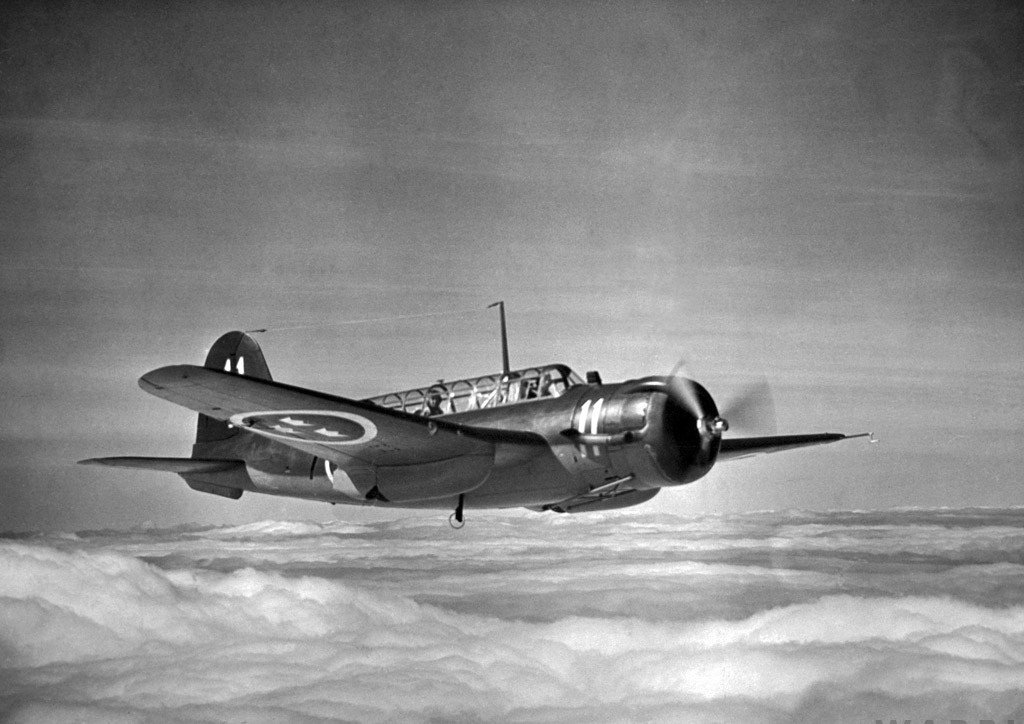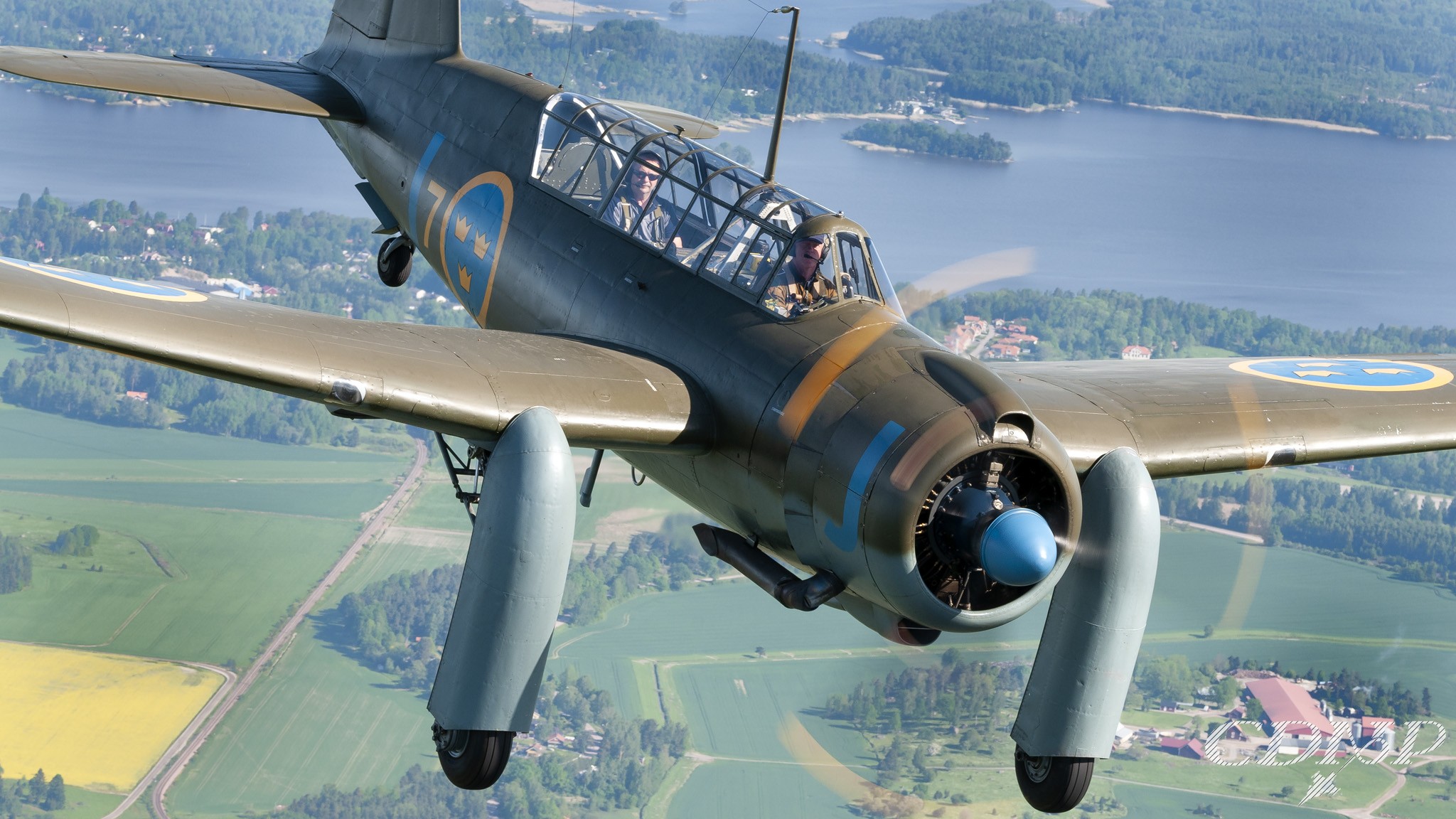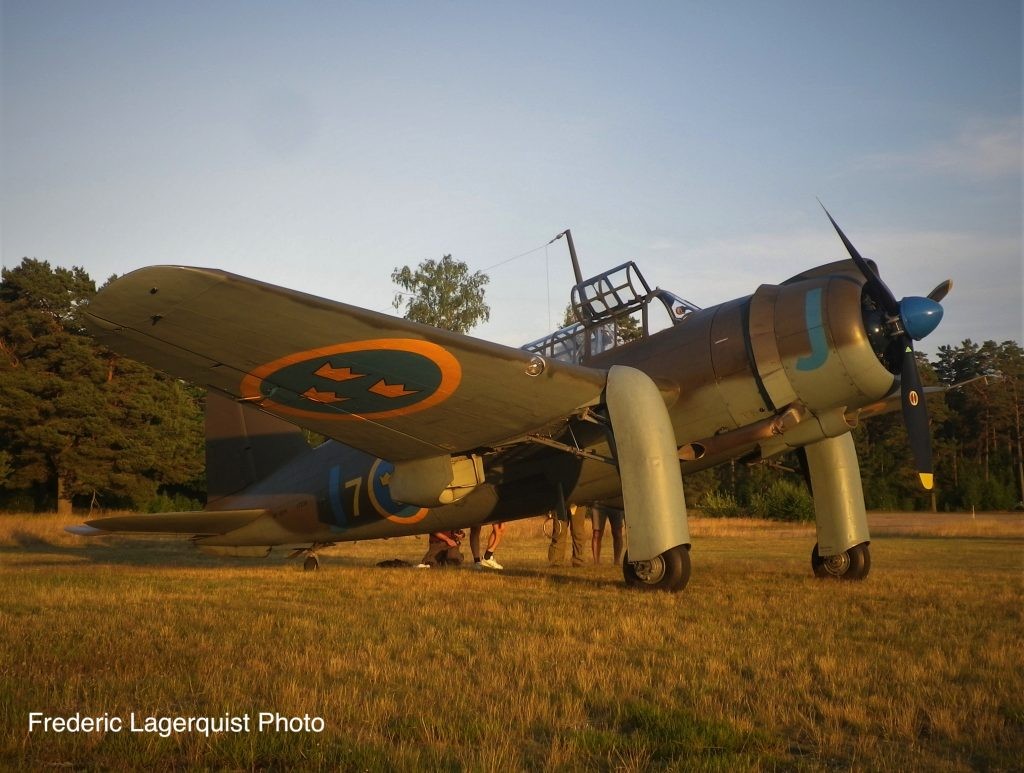
On July 2nd, 2021 the world’s only airworthy SAAB B 17 attended the Lae Flying Weekend, a fly-in event organized by the Norra Smålands Flygklubb, a flying club located right in the heart of Sweden. This event marked the aircraft’s first public appearance since brake failure temporarily grounded the aircraft in September, 2020 (Johan Sjöstrand performed the test flight after repairs and modification to the tail wheel on May 28th, just in time for the July show). For the occasion, Björn Rystedt, SAAB Aerospace’s Chief Engineer and the B 17’s pilot, sent us an article about the history of the type and the restoration of SAAB B 17A s/n 17239 – better known as Blå Johan, her squadron callsign. More about this unique warbird will come in a future issue of Warbird Digest Magazine, so stay tuned!
Restoring a SAAB B 17 Dive Bomber
by Björn Rystedt
Wait, what?!!…. B 17s weren’t capable of dive-bombing, were they? Well, perhaps not the B-17 most of us are more familiar with, Boeing’s legendary Flying Fortress, however Svenska Aeroplan AktieBolag – better known as SAAB – designed their B 17s for such a role from the outset! Developed during World War II, the SAAB 17 was one of the Swedish Air Force’s main frontline combat aircraft. While the type didn’t serve the Swedes for long, with the Saab A 21 replacing it as the nation’s primary attack aircraft soon after the war’s end, it was still a notable design.
Development of the SAAB B 17
Sweden employed dive-bombing techniques from early on in its history. In fact, AB Flygindustri (in Malmö, Sweden) collaborated with Junkers in the development and manufacture of the Junkers K 47 during early 1930, and these aircraft both helped develop German dive-bombing tactics and led to the (in)famous Junkers Ju 87 Stuka.
By 1936 Sweden had drawn up a defense plan which required the establishment of four new bomber wings. The nation’s air force already employed a number of imported or license-built aircraft, including the Northrop 8A-1 dive bomber, which they redesignated as the B 5 (B being short for ”Bomber”). However, the Swedish Air Force needed a multi-role aircraft which, in addition to dive-bombing, could perform reconnaissance and forward air observer missions as well. The government decided that this new aircraft should be of Swedish design.

Therefore, ASJA (AB Svenska Järnvägsverkstäderna Aeroplanavdelning), with support from engineers at the Douglas Aircraft Company, developed the L-10 project in response to the military’s request for proposals. They presented a wooden mock-up of the new design to Swedish Air Force staff in August 1938. This resulted in the November 11, 1938 contract, signed by AFF (AB Förenade Flygverkstäder) and ASJA, for the development of a prototype aircraft, named P 7. While this was going on, consolidation in the Swedish aircraft industry began taking place. By March 1939, AFF had ceased trading and SAAB moved from Trollhättan to Linköping and absorbed ASJA’s production facilities and gained responsibility for continuing the design for the L-10.
It took a little over a year for SAAB to complete the prototype P 7/L-10, which first flew on May 18th, 1940 with Saab chief test pilot Claes Smith at the controls. This first flight nearly ended in tragedy, with the forward canopy hatch coming free and striking Claes Smith in the head, but despite his injuries, the pilot managed to land the new aircraft without further complication. Following testing, the Swedish Air Force approved the manufacture of production examples, ordering the dive bomber variant as the B 17 and the reconnaissance examples as the S 17.
The SAAB B 17 has some unique design features, the most notable of which are the massive, main landing gear door covers. These serve as dive brakes; during a dive-bombing run, the pilot will lower the landing gear, which extends these highly drag-inducing gear doors into the slipstream, limiting the aircraft’s speed in a 70-degree dive to no more than 500 kph, thus helping bombing accuracy and safe aircraft pullout after ordnance release.
SAAB built a total of 322 B 17s in three different versions, which primarily depended upon which engine type they used. The B 17A flew with a 1,065hp Pratt & Whitney Twin Wasp C-3 (which Sweden later copied, without a license, as the STWC-3), the B 17B fielded a 980 hp Bristol Pegasus Mk.XXIV while the B 17C used a 1,000 hp Piaggio P XI RC 40D. For winter conditions, the aircraft could operate with skis in place of the wheels. There was also a floatplane version, the S 17BS (the initial S in the designation refers to ”Spaning”, i.e. “Reconnaissance” with the other S is short for ”Sjö”, i.e. ”Sea”).
| Saab B17A | Junkers Ju 87B | Douglas SDB Dauntless | |
| Speed | 435 km/h | 340 km/h | 410 km/h |
| Range | 975 km | 600 km | 900 km |
| Gun | 2 x 8 mm fixed-wing and 1×8 mm gunner | 2×7,9 mm fixed-wing and 1×7,9 mm gunner | 2×12,7 mm fixed-wing and 2×7,62 mm gunner |
| Bomb | 700 kg | 500 kg | 1015 kg |
The performance comparison between the SAAB B 17 and other well-known, WWII-era dive bombers.
During WWII, Danish pilots in exile underwent training in Sweden, resulting in the formation of a Danish B 17 squadron with 15 B 17Cs. This unit had been established in case they were needed in the liberation of Denmark, as the Germans had conducted a scorched-earth policy when leaving other nations they occupied, but thankfully the war ended before that could occur in Denmark. The aircraft remained in Sweden following the cessation of hostilities.
There was one export customer for the SAAB B 17, however. When the Imperial Ethiopian Air Force ordered the SAAB 91 Safir as their basic trainer in the late 1940s, the Swedish pilot Count Carl von Rosen organized Ethiopia’s military flying school. He learned that in addition to the Safir trainers, the Ethiopians also wanted combat aircraft, so naturally, von Rosen thought of the SAAB B 17. On November 13th, 1947 the first sixteen ex-Swedish Air Force B 17s arrived in Ethiopia. In total, the nation received 46 B 17As, with some of these aircraft remaining in service as late as 1970!
Today, just five SAAB B 17s remain extant. Besides the subject aircraft of this article, s/n 17239, there is S 17BL s/n 17005 at the Swedish Air Force Museum in Linköping, B 17A s/n 17320 at the Danish Technical Museum in Helsingör, and two ex-Ethiopian B 17As (s/n 17273 and 17365) owned by John Sayers of Johannesburg, South Africa. The latter two airframes are presently stored in Lithuania.
Saab B 17A s/n 17239 – Blå Johan
On May 26th, 1943 SAAB flew B 17A s/n 17239 from their factory in Linköping to Trollhättan for pre-delivery flight testing, which took place on July 23, 1943. Four days later, the company formally handed the aircraft over to the Swedish Air Force’s F 7 Wing in Såtenäs. However, due to a lack of engines, technicians removed the aircraft’s STWC-3 powerplant and returned it to SAAB to enable their more rapid delivery of further airframes to the military. In the interim, the aircraft underwent modifications to bring it up to the current specifications for the type. On December 1st, 1943, the Swedish Air Force assigned s/n 17239 its squadron codes, designated the aircraft as Blå Johan – or Blue John in English – where Blue is the color of the second squadron in a Swedish Wing while “J” is the aircraft’s individual identifier.

On April 27th, 1945, Blå Johan made a heavy landing, incurring damage to the left-wing. The accident resulted from a faulty airspeed indicator causing the pilot to reduce his airspeed below minimums during his runway approach. The aircraft underwent repairs and was soon flying again, however, on June 6th, 1945, the aircraft struck a parked B 5 during take-off and suffered significant damage for a second time. Patched up and returned to service, she was involved in a further incident two years later in June 1947, when a dummy bomb dropped onto the ground and bounced back up high enough to strike the fuselage!
In early 1948, the aircraft returned to SAAB for dual-control modifications, with a stick in the back seat and delivered to the third squadron at F 14 Wing in Halmstad. The last flight for 17239 in military service was performed July 3, 1951, when a faulty magnet forced the pilot to perform an emergency landing at F 1 wing in Västerås.
In March 1954, 17239 underwent modifications at F 1 Wing for use as a target tug. The aircraft was painted yellow and received the civilian registration SE-BYH. While the airframe was still owned by the Swedish government, the civilian corporation, Svensk Flygtjänst AB in Stockholm, was responsible for operating her.
In November 1957, SE-BYH transferred to another company, Avia in Visby, for target towing duties. Here she would remain until her final service flight on June 30th, 1968. After this flight, the maintenance team discovered her engine had a damaged cylinder; this effectively grounded the aircraft. Interestingly, one of Avia’s most experienced pilots was Birgit Thüring, so far the only woman to fly a Saab B 17. During the autumn of 1969, SE-BYH was transported to the historical aircraft collection in Linköping and placed in storage, awaiting the construction of the planned-for Swedish Air Force Museum.
Restoration of Blå Johan
During a dinner meeting at the Air Force Museum in Linköping in September 1995, Saab’s public relations manager, Anders Annerfalk, raised the idea of restoring SE-BYH back into airworthy condition. Saab AB’s 60th anniversary celebrations were due in 1997, and the B 17 would make a wonderful sight in the air alongside more current Saab-built aircraft in the present military fleet. Jan Nygren, the head of Saab Military Aircraft, liked the idea and discussed the practicalities that same evening with the head of the Swedish Air Force Museum, Sven Scheiderbauer.
On September 18, 1996, the first project meeting took place, with Lennart Petersén appointed project manager. Soon afterward, SE-BYH was transported from storage to the Air Force Museum maintenance shop where she underwent a thorough inspection. Her instruments went to FFV Aerotech AB for evaluation.

The restoration team soon got to work. One of the first things they did was remove the superfluous tow winch installation from her civilian target tug days. They removed the fabric-covered control surfaces for refurbishing. Gulli Mjärdesjö, who had worked at Saab on this type of fabric work from the age of 15 until she retired was responsible for applying the new fabric.
Another team disassembled the engine to repair the damaged cylinder from her last flight in 1968. The propeller went to Norrøna Fly-in Norway for maintenance. A new rear canopy and also new landing gear from the Air Force Museum collection were sourced and installed. As they proceeded with their work, they discovered evidence of old structural damage on the aircraft’s belly, likely caused by that bouncing dummy bomb in 1947!
A team then towed the aircraft from the Air Force Museum through the town of Linköping to Saab AB where they removed her old paint. Following this work, they towed her back to the Air Force Museum.
After a lot of work on the engine, they test ran it for the first time on April 1, 1997; after 29 years in storage, the powerplant roared back to life – with some extra smoke and fire for effect!

All told it took 9,949.4 hours of work from 28 volunteers over the course of 193 days before Blå Johan was ready to fly again. The aircraft was still in bare aluminum with only the rudders painted in military green. Kjell Nordström had the honor of taking her aloft for the first test flight on June 11, 1997; he used the radio call sign Swedish Bertil 17 for B 17. After one hour of a successful flight, Kjell Nordström gave Blå Johan the thumbs up; everything worked as required in the 1943 Swedish Air Force Flight Manual. In 2000, the Blå Johan restoration team received the FAI Phoenix Award for best restoration work!
Blå Johan is still flying today, operated by Saab AB. She wears the same color scheme she wore when first delivered to 2 squadron F 7 wing, although there are some discussions about how correct this paint is. But there are very few pictures of this specific aircraft from that time that we cannot be 100% sure of; there were big differences back then, even amongst aircraft in the same squadron. The plan is to keep Blå Johan airworthy through at least the Swedish Air Force’s centenary celebrations in 2026 and Saab AB’s 90th anniversary in 2027. More about this unique warbird will come in an upcoming Warbird Digest Magazine, make sure to subscribe HERE.



Be the first to comment
Graphic Design, Branding and Aviation Art